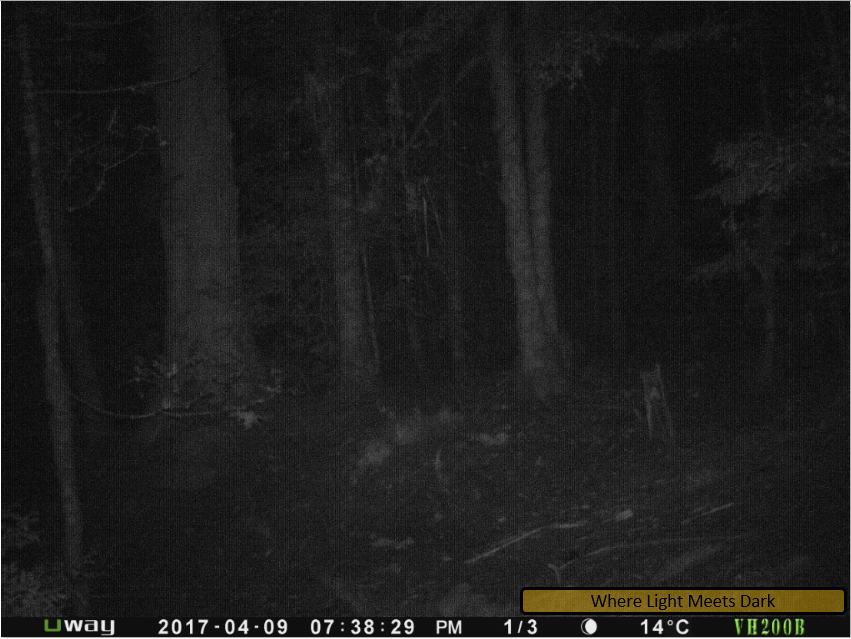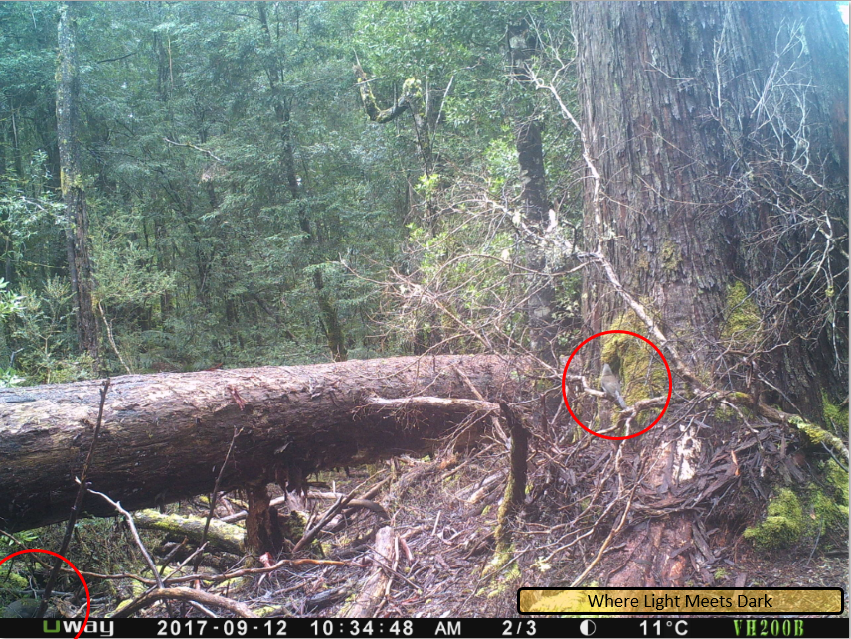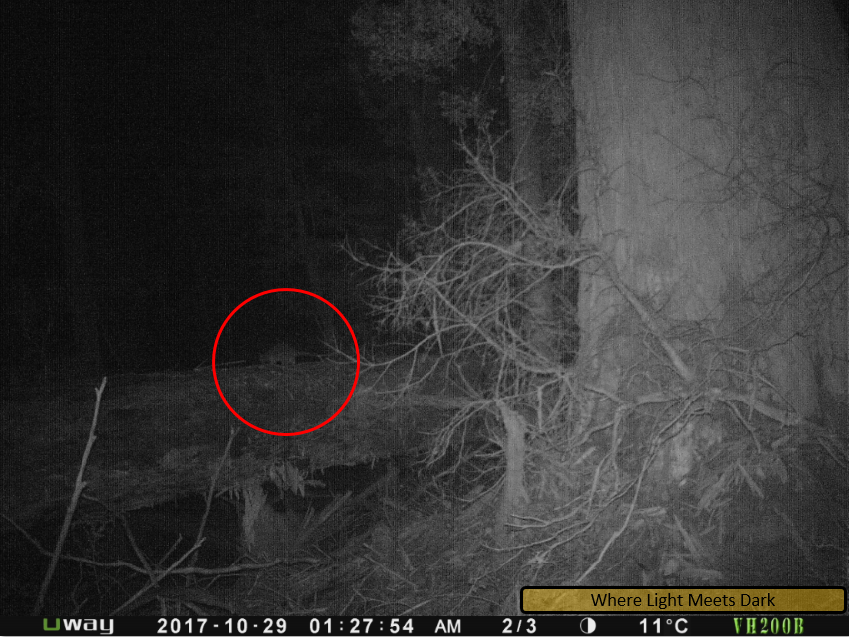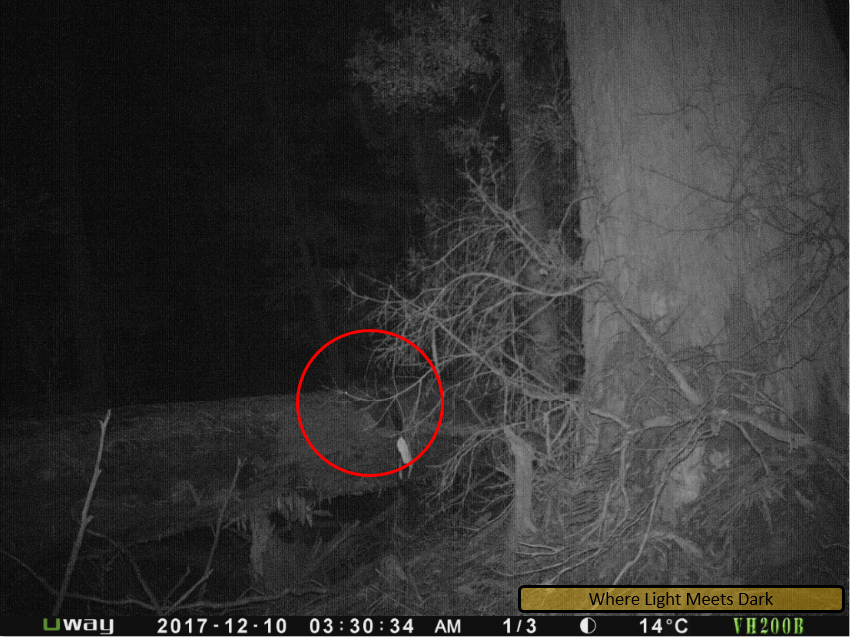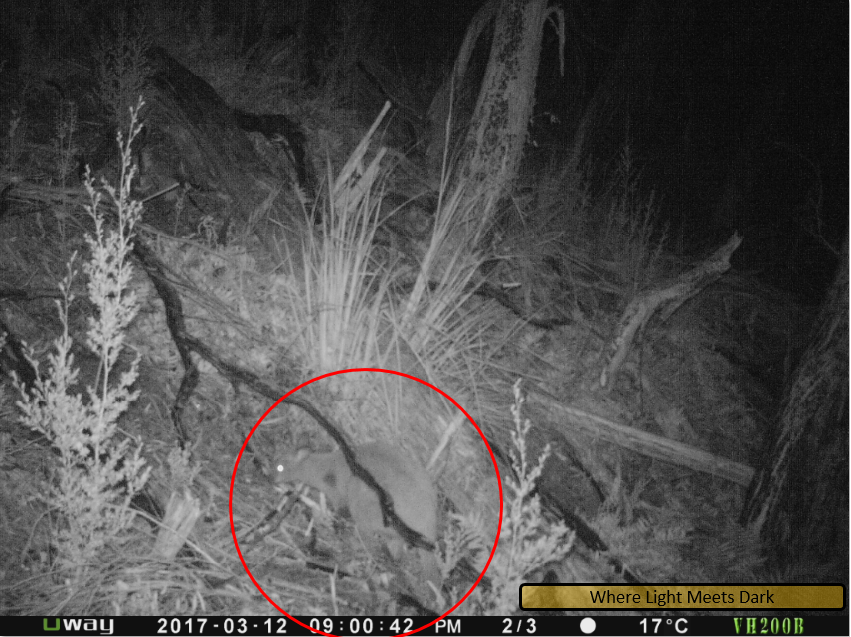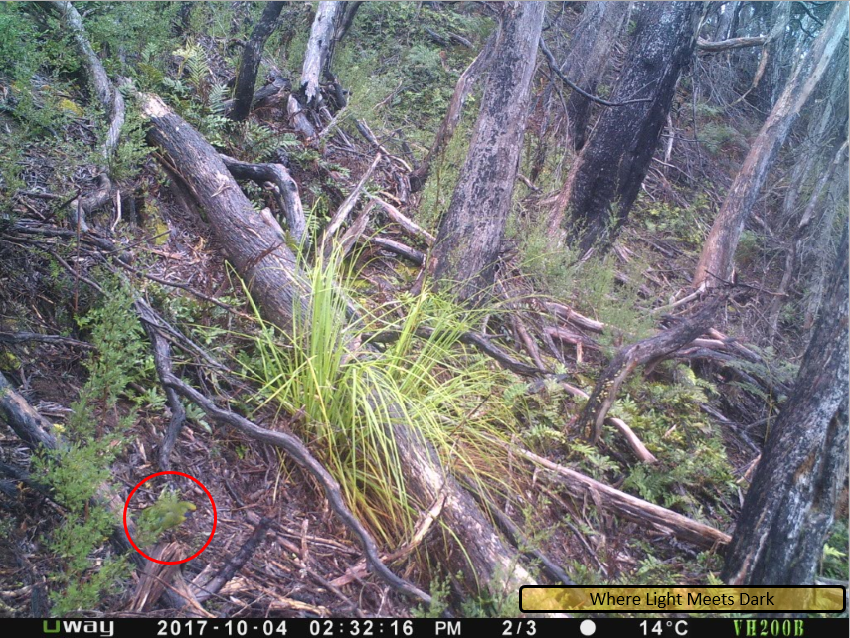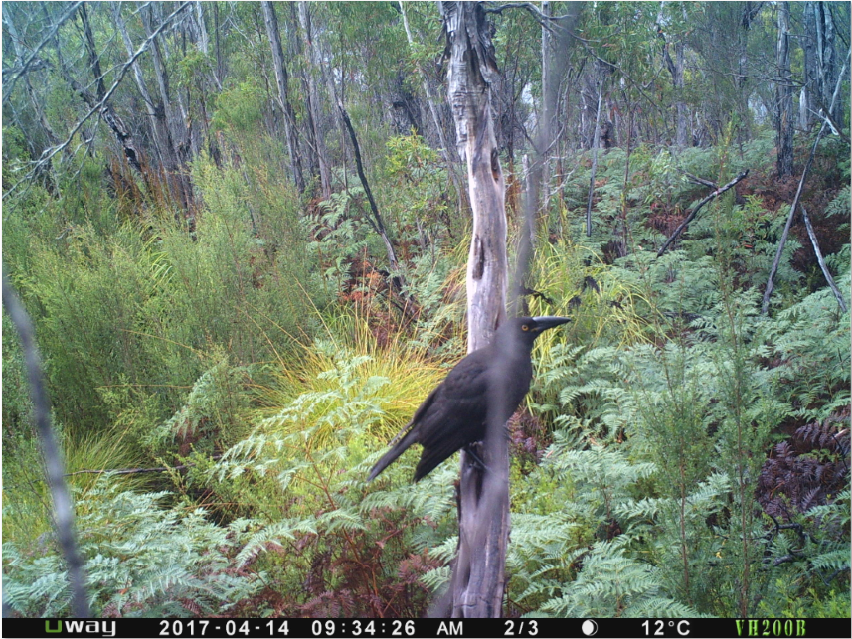Tiger trek 2018-1
Overview
In January 2018 I returned to Tasmania to check on the cameras that had been deployed during trek 2017-1, almost one year prior. During the prior expedition, Rob and I heard and recorded an animal making a repeated yipping sound. Six cameras were deployed in that area at various elevations.
Three cameras and one audio recorder were deployed to another site nearby.
Camera results
Of the six cameras:
- One failed to run - likely due to batteries coming loose while strapping up the camera on deployment
- One suffered water incursion, which led to blurry photos before finally leading to a battery leak that short-circuited the camera, rending it permanently useless
- One filled its card with 8,000+ images within one week due to repeated triggers by foliage movement (despite best efforts to avoid these false triggers).
Despite these shortcomings, usable photos were still retrieved from five cameras. Four of these showed fauna. The one that did not show any obvious fauna was not one of those listed above.
While hiking with these cameras in my pack, one further camera suffered physical damage to the motion sensor, also rending it permanently useless.
In some ways the above results were disappointing, but all was not lost. Survey effort was completed at varying altitudes and yielded images of several fauna species. Only a few images show an animal that could not be reasonably identified but this was likely too small to be a thylacine.
No cats, devils or quolls were recorded. Two new types of animal captured were Tasmania's green rosella and frogs. Frogs were seen during camera retrieval also.
Tiger 1 - intersection of gully and various animal trails
Many animal trails led into the clearing where two gullies merged. Despite this, no animals were detected by this camera. This camera suffered water incursion which led to blurred/foggy images before a battery leak short-circuited the camera.
Tiger 1 - sample daytime view
Tiger 1 - Sample night time view
Tiger 2 - fallen tree forming log crossing of gully
This camera was deployed at the location estimated by Rob and I to be the source of the initial yips we heard on expedition 2017-1.
Tiger 2 - showing unidentified bird (toward right) and unknown animal on the ground (bottom left)
The unknown animal may be a wombat as the 3 photos captured during this trigger show it moving along the ground, retaining this basic rounded shape and not showing any other obvious body features.
Tiger 2 - composite showing enlargements of the 3 images captured, showing the unidentified mammal.
Tiger 2 - composite showing 3 photos captured in one trigger, showing unidentified macropod moving past tree base.
This image illustrates just how hard it can be to notice even a large mammal within the frame. In truth, scanning through these images involves a process of cycling through the images one after another, so in this way it is easier to notice changes in an area of an image from one image to the next. Despite this, many images show no apparent animal, so it is easy to miss something like the wallaby seen here.
Tiger 2 - night time shot showing probable ringtail possum.
A ringtail possum was heard near this location during 2017-1. Ringtail possums are common throughout much of Australia, including Tasmania.
Tiger 2 - showing probable brushtail possum.
Again, it is easier to discern the shape of this animal when cycling through the 6 images that were captured as a result of 2 consecutive triggers. The animal began on the ground near the tree base at right, then jumped up onto the log, first looking left (as can be seen by the tiny eyeshine dot, here) before then looking right.
Tiger 2 - daytime shot with no obvious source of the trigger.
This image is included to highlight just how differently the camera renders the image, compared with earlier daytime shots, depending on lighting conditions. Camera traps are programmed to automatically accommodate lighting conditions at the time of trigger and in forest conditions the lighting can be extremely variable.
Tiger 3 - steep slope
Tiger 3 - night time shot showing one of three differently sized macropods captured in exactly the same position on different days.
This appears larger than a pademelon and is likely either a wallaby or eastern grey kangaroo (called forester kangaroo in Tasmania).
Tiger 3 - daytime photo of a macropod in the same area.
Tiger 3 - composite showing frog leap.
In the left frame, the frog is not even discernible as an animal - it appears as a diagonal line. In the second frame the frog has leapt toward the left. The eyeshine is visible and the body shape is vaguely identifiable. Again, alternating between these two frames makes the differences between them more obvious. Images captured on other days also showed frogs. This is the first time frogs have been identified during these deployments.
Tiger 3 - showing five currawongs.
The right-most currawong is barely a streak of feathers as it flies out of screen. This is the largest number of currawongs captured in an image during this deployment, but higher numbers have been captured previously.
Tiger 3 - showing probable whiskers
The pale vertical streaks in this image are probably possum whiskers as a possum looks down at the camera while perched above it on the same tree trunk. They may be quoll whiskers. Images captured on other days also showed whiskers.
Tiger 3 - showing a green rosella.
The green rosella is endemic to Tasmania and its offshore islands. This is the first time a green rosella has been captured during these deployments, although they are frequently seen and heard whilst hiking.
Tiger 4 - on hillside
This camera overexposed on the first shot of each trigger in most instances. The majority of images (2,000+) seem to have been triggered by foliage movement. Currawongs were also photographed.
Tiger 4 - showing currawong.
Tiger 4 - snow.
This is the first time snow has been captured during these deployments.
Tiger 5 - hillside
This camera failed to trigger. The most likely cause is a dislodged battery.
Tiger 6 - buttongrass on ridge top
The majority of images (8,000+) seem to have been triggered by foliage movement. This camera filled its memory card within a week. Only a macropod was captured during this time.
Tiger 6 - daytime view
Daytime view of the buttongrass plain atop a ridge.
Tiger 6 - macropod at night.
Animal tracks
A number of animal tracks were observed in mud patches whilst hiking on this trip. All of these photos have been posted to a Facebook gallery on the Where Light Meets Dark Facebook page, then embedded here. Feel free to comment on individual photos using Facebook - the comments with each photo should change over time with my thoughts being added over time as well.
Nest
In 2013 I discovered a nest under a rock overhang. The nest was positioned up on a rocky shelf and consisted primarily of dried button grass stalks and twigs. Further along the shelf there were wombat scats. Given the only known thylacine lair is described to have been constructed from dried fern fronds and leaves I dimissed the nest as being that of a wombat - unusual, for being above ground, but a wombat nevertheless. At that time a camera trap was aimed at the nest for a period of 12 months which resulted in zero triggers.
Nest - found under rock overhang in 2013. Marks on card are 1cm.
On this trip I returned to the nest with the intention of examining it more closely and searching for hair fibres. With the thylacine hair microscopy project completed last year, we now have an extensive reference library of images with which to compare samples collected in the field. New photographs of the nest were taken, this time with a scale in place, and the nest materials were examined further. The nest appeared unaltered compared with five years prior and is probably not used. A sample of nest material was collected for the purpose of extracting hair fibres, should they be found. Results from this investigation, if any, will be published in future.
Nest - close up showing the nesting material - suspected to be dried button-grass blades and twigs from unknown trees.
Context of the nest - the nest can be seen up the back, on high ground, with a shelf leading off to the right for access.
I have since sought opinion from wildlife professionals on the origins of the nest. While a collated summary of Tasmanian mammal nesting habits appears absent, one opinion suggested a strong likelihood this nest belonged to a Tasmanian devil as a daytime shelter. This opinion was based on what appear to be devil scats in one of the photos taken. I am inclined to agree the size of the depression seems to suit devil (or quoll) better than wombat or thylacine.
Scats
Two notable scats were encountered. The first contained shards of bone material and is likely to have originated with a Tasmanian devil for this reason. The thylacine was said to be a "blood feeder" eating the softer tissues and never the bones. The scat contained hair fibres and a sample of these was collected for microscopic analysis.
The second scat was very fresh, large (9cm) and appeared on a track the second time I walked the track - that is, appears to have been deposited during the few hours between the two times I travelled this track. It is possible that I missed observing it the first time along the track but either way the scat was fresh. This scat contained no bone material but much hair. Several fibres were collected from this scat also.
New deployments
Cameras
With 2 of 6 cameras destroyed, I decided to redeploy 3 of the remaining 4. One is targeted at the (presumably disused) nest. One was deployed near to where the large scat appeared while I was hiking in the area, and the third has been deployed elsewhere.
Audio recorder
To recap, in 2013 I heard a series of double yip calls across a valley ('yip yip, yip yip, yip yip, yip'). That event led to the choice of destination for the trek in 2017 during which Rob and I heard 2 types of yip call. There were mutiple series of single yips, much of which we recorded, and there was a single incident involving 6 or 7 double yips - again at a distance, and this time again from back on the other side of the valley - which we did not record.
The cameras collected during this trip had been deployed last year in response to the above vocalisations. No similar vocalisations were heard on this trip but an audio recorder has been deployed in an effort to begin to understand the nocturnal audioscape in the region of the calls that were heard earlier.
Audio recorder - set to record audio every night for two months.
I will be actively looking for sponsorships to help fund audio research in Tasmania.
My hope is that the audio recorder will record the two types of call heard in 2013 and 2017.
If the double-yip is recorded, this will be the jackpot, as this is the nearest vocalisation to the text descriptions that I have read - obtaining a sample of this animal call will allow me to consult with field, wildlife and bioacoustic experts to seek opinions on the call.
If the prolonged series of single yips is recorded this will provide higher quality audio than was recorded using iPhones in 2017. Further, this will give an indication as to how common this (or the other) call really is. If the series of single yips proves to be from an owl, this will be notable in itself, as no bird experts were able to confirm hearing this from a boobook before. If it proves to be from a sugar glider, then the frequency with which such a call is heard will be measured. The possibility remains that it originates with something else, also.
Finally, I believe there is value in simply mapping the nocturnal audioscape for all species captured this way, and I will be seeking ways in which to contribute the audio data collected to the broader research community. As such, if you know someone who may be interested in supporting this project, please ask them to get in touch.
Lessons learned
Having a camera fill up with 8,000 photos in under a week is a good reminder to plan camera positioning to minimise false triggers generated by foliage movement. This can be done by deploying in shaded areas (full tree canopy) although this obviously limits your deployment habitats. This can also be aided by reducing the camera sensitivity - which ideally should be tested in-situ for at least 24 hours per location - something which is not always feasible. Facing away from east/west can also help as the sun rises/sets in these directions.
Currawongs regularly triggered the cameras, which is no surprise. However with this camera model, at least, they often render as a faint blur as they fly through the scene. For some images where there is no apparent source for the trigger, it may be found that a currawong has flown through the image and left only a trace rendering.
Frogs can trigger the cameras, even if they render as very small in the frame.
The dry watercourse/gully produced no obvious images of animals.
The fallen tree trunk - effectively forming a log bridge over a gully - was utilised by some wildlife but is perhaps not the expected location for photographing animals. Regardless, wildlife did utilise this tree and other animals navigated past a large standing tree trunk in very close proximity, even to the point of having to push through foliage even though there were clearer paths around the tree nearby.
All cameras were set to capture 3 images per trigger. In some cameras the first image was overexposed while the 2nd and 3rd images were well exposed. In another camera the first image per set was underexposed. In some cameras, while capturing infrared light (ie night time, or low light shots), the first image rendered the timestamp as part of the image, along the bottom, but the 2nd and 3rd images in a set lacked this watermark. These idiosyncrasies are likely to be model- or camera-specific.
Prior to taking down a camera, it is advisable to attempt to trigger it - if it succeeds, this will verify that the camera should have been active throughout the full deployment period.
All cameras were the now discontinued UWay VH200B models using 12x AA batteries as 1x 8GB Sandisk SD card.

